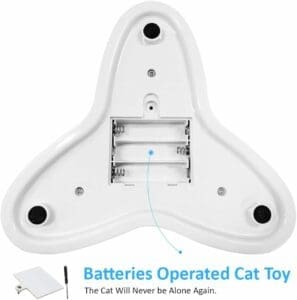Have you recently welcomed a cute furry friend into your home and want to ensure they have good litter box habits? Look no further! In this article, we will guide you through the step-by-step process of litter box training your cat or kitten. From choosing the right litter box and litter, to establishing a routine and troubleshooting common issues, we’ve got you covered. Say goodbye to unwanted messes and say hello to a happily trained feline companion!
Choosing the Right Litter Box
Choosing the right litter box for your cat is crucial to ensure their comfort and ease of use. One important factor to consider is the size of the litter box. It should be large enough for your cat to comfortably move around and dig in. It should also have tall sides to prevent litter from being kicked out. Additionally, if you have a senior cat or a kitten, opt for a litter box with low sides to make it easier for them to get in and out.
Another consideration is the type of litter box. There are several options available, including traditional open litter boxes, covered litter boxes, and top-entry litter boxes. Open litter boxes provide easy access and allow for proper ventilation, but they may not offer much privacy. Covered litter boxes can provide privacy and reduce litter scatter, but they may not be suitable for cats who dislike confined spaces. Top-entry litter boxes are a great option for preventing litter tracking, but they may not be suitable for cats with mobility issues. Take into account your cat’s preferences and needs when choosing the appropriate litter box type.
Additionally, it is important to place the litter box in a quiet and private area. Cats value their privacy when using the litter box, so placing it in a quiet and secluded spot will make them feel more comfortable. Avoid placing the litter box in high-traffic areas or places where there might be loud noises. A calm and peaceful environment will encourage your cat to use the litter box regularly.
Choosing the Right Litter
Choosing the right litter is just as important as choosing the right litter box. One of the most popular options is clumping litter, as it forms solid clumps when wet, making it easier to remove and maintain cleanliness. Clumping litter also helps to control odor effectively. Non-clumping litter is cheaper but requires more frequent cleaning as it does not clump together.
When selecting litter, it is best to avoid scented varieties. While you may find the fragrance appealing, your cat may not share the same sentiment. Cats have a strong sense of smell and scented litter can be overwhelming and unpleasant for them. Stick with unscented litter to ensure your cat’s comfort.
Consider your cat’s preferences when choosing the litter. Some cats have sensitivities to certain textures or materials, so it may require some trial and error to find the litter your cat prefers. Experiment with different types, such as clay, silica gel, or natural litter made from materials like corn or wheat, to see which one your cat prefers. Additionally, if you have multiple cats, it is a good idea to provide different litter boxes with different types of litter to accommodate their preferences.
Maintaining a clean and odor-free litter box is essential. Scoop the litter box daily to remove solid waste and clumps. This will keep the litter fresh and prevent odor buildup. Also, completely replace the litter at least once a month or as needed to maintain cleanliness and prevent bacteria growth. Your cat will appreciate a clean litter box and be more inclined to use it consistently.
Introducing Your Cat to the Litter Box
Introducing your cat to the litter box is a critical step in litter box training. Start by showing your cat the location of the litter box. Allow them to explore the space and familiarize themselves with it. Make sure the litter box is easily accessible and visible to your cat.
After meals, place your cat in the litter box. Cats have a natural instinct to eliminate after eating, so this is an opportune time to encourage them to use the litter box. Gently place them in the box and let them sniff around. If they start to dig or show signs of wanting to go, praise them and offer positive reinforcement to reinforce the behavior.
Using positive reinforcement and rewards can greatly aid in training your cat to use the litter box. Whenever your cat successfully uses the litter box, reward them with verbal praise, petting, and treats. This positive association will help reinforce the desired behavior and encourage them to continue using the litter box consistently.
Teaching Your Cat to Use the Litter Box
When teaching your cat to use the litter box, it may be necessary to gently place them in the litter box initially. If you notice your cat showing signs that they need to eliminate, such as sniffing around or squatting, calmly pick them up and place them in the litter box. Allow them to explore and do their business. Be patient and give them time to get comfortable with the process.
Observing your cat’s digging and covering behavior is also helpful in ensuring they are using the litter box correctly. Cats have an instinctive behavior of digging in the litter and covering their waste. If your cat is not displaying this behavior, gently take their paws and show them how to dig and cover their waste in the litter. Be patient and repeat this process as needed until they understand.
Monitoring your cat’s litter box habits is essential. Keep an eye on their frequency of use and note any changes in behavior. If your cat suddenly starts avoiding the litter box or shows signs of distress while using it, there may be an underlying issue that needs to be addressed. Tracking their litter box habits will help you identify potential problems early on so you can seek veterinary attention if needed.
Handling Accidents and Mistakes
It is important to stay calm and avoid punishing your cat if accidents occur during the litter box training process. Yelling, hitting, or scolding your cat will only create fear and stress, making them less likely to use the litter box in the future. Instead, gently redirect your cat to the litter box and clean up any accidents promptly.
For accidents outside the litter box, it is crucial to use enzymatic cleaners. Ordinary household cleaners may not fully eliminate the odor, and the lingering scent can attract your cat to eliminate in the same spot again. Enzymatic cleaners break down the organic compounds in urine and feces, effectively eliminating both the odor and the urge for your cat to revisit the same spot.
If accidents persist or your cat consistently avoids the litter box, it is important to address potential medical issues. Cats may avoid the litter box if they are experiencing urinary tract infections, bladder stones, or other health problems. Consult with your veterinarian to rule out any medical conditions that could be contributing to the litter box issues.
Maintaining a Clean Litter Box
To ensure your cat’s comfort and promote good litter box habits, it is crucial to maintain a clean environment. Remove solid waste and clumps from the litter box daily using a scoop. This will prevent odor buildup and keep the litter fresh.
Regularly clean the litter box by emptying the litter and washing it with mild, unscented soap and water. Avoid using harsh chemicals or strong-scented cleaners, as these can be aversive to your cat. Dry the litter box thoroughly before adding fresh litter.
Replace the litter when necessary. Over time, the litter may become soiled or clumps may start to break apart, making it difficult to maintain cleanliness. As a general rule, completely replace the litter at least once a month or more frequently if required.
Avoiding Common Litter Box Problems
Litter box aversion is a common issue among cats. If your cat is consistently avoiding the litter box, there may be underlying reasons such as cleanliness, location, or even the type of litter used. Ensure the litter box is kept clean and free of odor. Experiment with different locations to find one that offers privacy and doesn’t have any distractions or loud noises nearby. Additionally, try switching to a different type of litter to see if it makes a difference.
Litter box territoriality can also be a problem in multi-cat households. Cats may display territorial behaviors by marking their territory or even fighting over access to the litter box. To address this, provide multiple litter boxes in different locations to prevent competition. Aim for at least one litter box per cat plus an extra. Ensure each litter box is easily accessible and in a quiet area.
Preventing litter tracking and scatter can help keep your home clean. Place a litter mat or tray outside the litter box to catch any loose litter as your cat exits. This will help prevent litter from being tracked throughout the house. Consider using a litter box with high sides or investing in a litter box with built-in tracking prevention features, such as a top-entry design.
Troubleshooting Litter Box Issues
If you are experiencing persistent litter box problems despite following all the guidelines, it may be necessary to identify and address underlying causes. Stress, anxiety, changes in the household, or even a new pet can disrupt a cat’s litter box routine. Take note of any changes or disruptions in your cat’s environment and try to address them accordingly. Creating a calm and predictable environment can help resolve litter box issues.
If you have tried various solutions and are still struggling with litter box problems, it may be beneficial to consult with a veterinarian or an animal behaviorist. They can assess your cat’s behavior, identify any underlying medical conditions, and provide further guidance on how to address the litter box issues effectively.
Transitioning from Outdoor to Indoor Litter Box
If you are transitioning your cat from being primarily outdoors to using an indoor litter box, it can be a gradual process. Start by introducing the indoor litter box in a specific area where your cat frequently eliminates outdoors. This will help them associate the scent and location with the act of elimination.
Provide outdoor alternatives such as a designated area with grass or soil for your cat to eliminate in. Gradually reduce the availability of outdoor options as your cat becomes more comfortable using the indoor litter box. Be patient during this transition period and provide positive reinforcement when your cat uses the litter box successfully.
Monitor your cat’s progress and adjust as needed. If your cat continues to have accidents indoors or shows resistance to using the litter box, it may be necessary to seek guidance from a veterinarian or animal behaviorist to ensure a successful transition.
Helping Multiple Cats Share a Litter Box
For households with multiple cats, providing multiple litter boxes is essential. Aim for at least one litter box per cat, plus an additional one. This will help prevent competition and territorial behavior.
When setting up multiple litter boxes, consider their locations. Spread them out in different areas of your home to offer each cat easy access and privacy. Avoid placing litter boxes in tight spaces or areas where cats could feel trapped or cornered. Each litter box should be in a quiet and peaceful area to promote a stress-free environment.
Address potential conflicts and hierarchy among cats by monitoring their interactions around the litter boxes. If you notice any aggressive behaviors or tension, it may warrant separate litter boxes for each cat in different parts of the house. This will help alleviate any stress or competition and ensure that each cat has their own designated space.
By following these guidelines and providing a suitable litter box and litter for your cat, you can establish good litter box habits and maintain a clean and odor-free environment. Remember to be patient and provide positive reinforcement, and consult a professional if you encounter persistent issues. Your cat will appreciate having a comfortable and inviting litter box experience.








